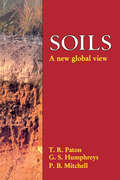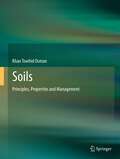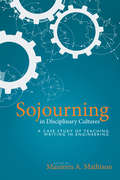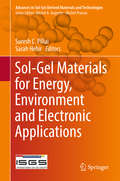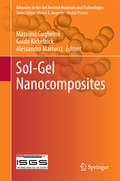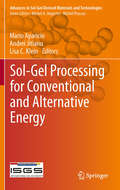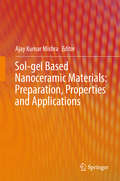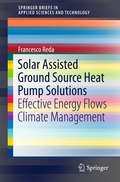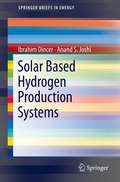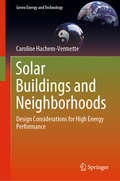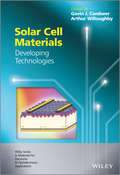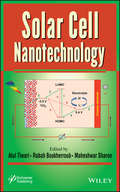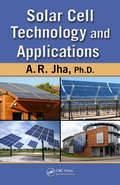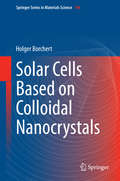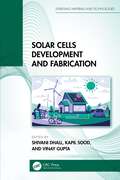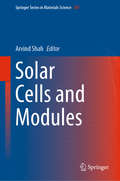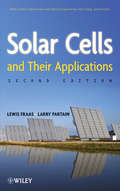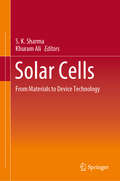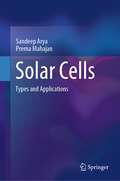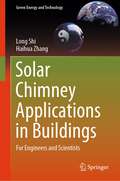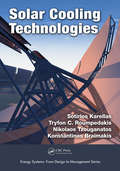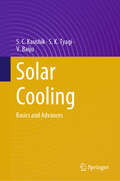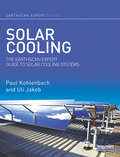- Table View
- List View
Soils: A New Global View
by Thomas Ronal PatonOffers a perspective on soils as earth materials, which establishes a pedological hierarchy of materials, processes and factors, and their rationalization in terms of plate tectonics. The book should interest soil and earth scientists.
Soils: Genesis and Geomorphology
by Randall J Schaetzl Sharon AndersonSoils: Genesis and Geomorphology is a comprehensive and accessible textbook on all aspects of soils. The book's introductory chapters on soil morphology, physics, mineralogy and organisms prepare the reader for the more advanced and thorough treatment that follows. Theory and processes of soil genesis and geomorphology form the backbone of the book, rather than the emphasis on soil classification that permeates other less imaginative soils textbooks. This refreshingly readable text takes a truly global perspective, with many examples from around the world sprinkled throughout. Replete with hundreds of high quality figures and a large glossary, this book will be invaluable for anyone studying soils, landforms and landscape change. Soils: Genesis and Geomorphology is an ideal textbook for mid- to upper-level undergraduate and graduate level courses in soils, pedology and geomorphology. It will also be an invaluable reference text for researchers.
Soils: Principles, Properties and Management
by Khan Towhid OsmanAimed at taking the mystery out of soil science, Soils: Principles, Properties and Management is a text for undergraduate/graduate students who study soil as a natural resource. Written in a reader-friendly style, with a host of examples, figures and tables, the book leads the reader from the basics of soil science through to complex situations, covering such topics as: the origin, development and classification of soil physical, chemical and biological properties of soil water and nutrient management management of problem soils, wetland soils and forest soils soil degradation Further, the ecological and agrological functions of soil are emphasized in the context of food security, biodiversity and climate change. The interactions between the environment and soil management are highlighted. Soil is viewed as an ecosystem itself and as a part of larger terrestrial ecosystems.
Sojourning in Disciplinary Cultures: A Case Study of Teaching Writing in Engineering
by Doug Downs Sarah Read Sarah A. Bell Linn K. Bekins Mara K. Berkland April A. Kedrowicz Julie L. Taylor Sundy WatanabeSojourning in Disciplinary Cultures describes a multiyear project to develop a writing curriculum within the College of Engineering that satisfied the cultural needs of both compositionists and engineers at a large R1 university. Employing intercultural communication theory and an approach to interdisciplinary collaboration that involved all parties, cross-disciplinary colleagues were able to develop useful descriptions of the process of integrating writing with engineering; overcoming conflicts and misunderstandings about the nature of writing, gender bias, hard science versus soft science tensions; and many other challenges. This volume represents the collective experiences and insights of writing consultants involved in the large-scale curriculum reform of the entire College of Engineering; they collaborated closely with faculty members of the various departments and taught writing to engineering students in engineering classrooms. Collaborators developed syllabi that incorporated writing into their courses in meaningful ways, designed lessons to teach various aspects of writing, created assignments that integrated engineering and writing theory and concepts, and worked one-on-one with students to provide revision feedback. Though interactions were sometimes tense, the two groups––writing and engineering––developed a “third culture” that generally placed students at the center of learning. Sojourning in Disciplinary Cultures provides a guide to successful collaborations with STEM faculty that will be of interest to WPAs, instructors, and a range of both composition scholars and practitioners seeking to understand more about the role of writing and communication in STEM disciplines. Contributors: Linn K. Bekins, Sarah A. Bell, Mara K. Berkland, Doug Downs, April A. Kedrowicz, Sarah Read, Julie L. Taylor, Sundy Watanabe
Sol-Gel Materials for Energy, Environment and Electronic Applications
by Suresh C. Pillai Sarah HehirThis volume provides expert coverage of the state-of-the-art in sol-gel materials for functional applications in energy, environment and electronics. The use of sol-gel technology has become a hotbed for cutting edge developments in many fields due to the accessibility of advanced materials through low energy processes. The book offers a broad view of this growing research area from basic science through high-level applications with the potential for commercialization and industrial use. Taking an integrated approach, expert chapters present a wide range of topics, from photocatalysts, solar cells and optics, to thin films and materials for energy storage and conversion, demonstrating the combined use of chemistry, physics, materials science and engineering in the search for solutions to some of the most challenging problems of our time.
Sol-Gel Nanocomposites
by Massimo Guglielmi Guido Kickelbick Alessandro MartucciThis book provides comprehensive coverage of nanocomposite materials obtained by the sol-gel method, from synthesis to applications and including design tools for combining different properties. Sol-gel nanocomposites are of great interest in meeting processing and application requirements for the development of multifunctional materials. These materials are already commercialized for a number of applications from scratch-resistant and anti-adhesive coatings to optical materials with active and passive properties. Biomedical applications, holographic recordings, fuel cells and hydrogen storage, resists and catalysts are among the potential uses. The novel mechanical, optical and electronic properties of nanocomposite materials depend not only on the individual component materials, but also on their morphology and nanoscale interfacial characteristics. Sol-gel is a highly versatile method for obtaining both the matrix and the filler of the nanocomposite and for chemically adjusting the interface to optimize structure and properties. Although nanocomposites are widely discussed in the literature, the focus has been mainly on polymer nanocomposites. This book addresses nanocomposites based on inorganic or hybrid organic-inorganic matrices, with an emphasis on the scientific principles which are the basis for nanocomposite sol-gel synthesis and applications. A didactic approach is followed, with different topics developed from a fundamental point of view together with key examples and case studies. First comprehensive treatment of nanocomposites obtained by sol-gel methods Focuses on nanocomposites with inorganic and hybrid organic-inorganic matrices Describes design tools to optimize structure and properties for various applications Covers synthesis, processing, characterization, and modeling Uses first principles to describe the influence of interfacial characteristics on materials properties Presents case studies for both films and bulk applications Provides examples of products on the market, with descriptions of the scientific principles at the base of their success Includes contributions from recognized leaders in this multidisciplinary area.
Sol-Gel Processing for Conventional and Alternative Energy
by Lisa C. Klein Andrei Jitianu Mario AparicioSol-Gel Processing for Conventional and Alternative Energy is a comprehensive source of information on the use of sol-gel processing in materials in energy systems, conversion, storage, and generation. The volume editors include numerous applications, primarily in nuclear fuel processing, electrolytes for fuel cells, and dye-sensitized solar cells (DSSC). In addition to examining contemporary processing, properties, and industrial applications, "Sol-Gel Processing for Conventional and Alternative Energy" identifies materials challenges presented by conventional and alternative energy generation that require new materials and innovative processing. Each chapter is written by an internationally respected researcher. The book provides a state-of-the-art treatment of different aspects of materials for energy production, with a focus on processing, and covers related topics such as carbon sequestration, clean energy, and biofuels.
Sol-gel Based Nanoceramic Materials: Preparation, Properties and Applications
by Ajay Kumar MishraThis book summarizes recent research and development in the field of nanostructured ceramics and their composites. It presents selected examples of ceramic materials with special electronic, catalytic and optical properties and exceptional mechanical characteristics. A special focus is on sol-gel based and organic-inorganic hybrid nanoceramic materials. The book highlights examples for preparation techniques including scale-up, properties of smart ceramic composites, and applications including e. g. waste water treatment, heavy metal removal, sensors, electronic devices and fuel cells. Recent challenges are addressed and potential solutions are suggested for these. This book hence addresses chemists, materials scientists, and engineers, working with nanoceramic materials and on their applications.
Solanum tuberosum: Methods and Protocols (Methods in Molecular Biology #2354)
by Kristina Gruden David Dobnik Živa Ramšak Anna CollThis volume offers a comprehensive collection of experimental approaches to study Solanum tuberosum (potato). Chapters are divided into five sections covering a general overview of potato, the research fields of molecular biology, omics approaches, and bioinformatics, and finally, the application of the generated knowledge for crop improvement. Written in the format of the highly successful Methods in Molecular Biology series, each wet-lab chapter includes an introduction to the topic, lists necessary materials and reagents, includes tips on troubleshooting and known pitfalls, and step-by-step, readily reproducible protocols. Authoritative and practical, Solanum tuberosum: Methods and Protocols aims to provide a collection of methods for the potato research community that will enable scientists gain insight into the world of the potato.Chapter 2 is available open access under a Creative Commons Attribution 4.0 International License via link.springer.com.
Solar Assisted Ground Source Heat Pump Solutions
by Francesco RedaThis book analyses solar-assisted ground-source heat pump systems, a technology meant for producing heating and cooling energy for buildings. It focuses on ground source heat pump, reversible central heating and cooling system that transfer heat from or to the ground, applications which use solar thermal collectors. Providing deep insights into energy-saving, solar thermal system operating strategies, it illustrates examples of useful configurations and controlling approach for different climates for different vertical ground heat exchanger depths. Offering an overview of solar assisted ground source heat pump systems, including design principles and energy-performance data for different climates, it is a valuable resource for designers and scientists who focus on building heating and cooling technologies.
Solar Based Hydrogen Production Systems
by Ibrahim Dincer Anand S. JoshiThis book provides a comprehensive analysis of various solar based hydrogen production systems. The book covers first-law (energy based) and second-law (exergy based) efficiencies and provides a comprehensive understanding of their implications. It will help minimize the widespread misuse of efficiencies among students and researchers in energy field by using an intuitive and unified approach for defining efficiencies. The book gives a clear understanding of the sustainability and environmental impact analysis of the above systems. The book will be particularly useful for a clear understanding of second law (exergy) efficiencies for various systems. It may serve as a reference book to the researchers in energy field. The definitions and concepts developed in the book will be explained through illustrative examples.
Solar Buildings and Neighborhoods: Design Considerations for High Energy Performance (Green Energy and Technology)
by Caroline Hachem-VermetteThis book presents the main principles for designing buildings and neighborhoods with increased potential to capture and utilize solar energy. It discusses practical issues in the design of the built environment and their impact on energy performance; and a range of design considerations, from building components (e.g. the building envelope) to urban planning issues (e.g. density and street layouts). In addition to design guidelines on how to increase buildings’ potential to capture solar energy, the book provides creative tips to increase the aesthetic value of solar technology integration in buildings. Helping readers plan energy-efficient buildings with innovative building envelope technologies, and to understand the impact of early-stage design considerations on the energy performance of buildings and communities, the book offers a valuable source of information for building professionals, including architects, engineers, and urban planners. It can also serve as a reference guide for academics and students of energy efficiency in buildings and urban planning.
Solar Cell Materials
by Gavin J. Conibeer Arthur WilloughbyThis book presents a comparison of solar cell materials, including both new materials based on organics, nanostructures and novel inorganics and developments in more traditional photovoltaic materials. It surveys the materials and materials trends in the field including third generation solar cells (multiple energy level cells, thermal approaches and the modification of the solar spectrum) with an eye firmly on low costs, energy efficiency and the use of abundant non-toxic materials.
Solar Cell Nanotechnology
by Atul Tiwari Rabah Boukherroub Maheshwar SharonFocusing on the cutting-edge technologies available in the field of photovoltaics, Solar Cell Nanotechnology explores the latest research and development activities related to organic, inorganic, and hybrid materials being used in solar cell manufacturing. Several chapters are dedicated to explaining the fundamentals of photovoltaics and nanomaterials utilized in the manufacturing of solar cells. Other essential subjects, such as microcontact printing, plasmonic light trapping, outdoor and indoor efficiency, luminescent solar concentrators, and photon management in photovoltaics, are comprehensively reviewed. Written for a broad audience, this is an essential book for engineers, nanotechnologists, and materials scientists.
Solar Cell Technology and Applications
by A. R. JhaEnergy experts predict that wholesale electricity prices could easily rise 35 to 65 percent by 2015. Add to this the growing need for energy independence and the need to reduce carbon emissions and it is very clear that the development of low-cost renewable energy, such as solar energy, is essential for our economy and our national security. With t
Solar Cells Based on Colloidal Nanocrystals
by Holger BorchertThis book presents a new system of solar cells. Colloidal nanocrystals possess many physical and chemical properties which can be manipulated by advanced control over structural features like the particle size. One application field is photovoltaics where colloidal semiconductor nanocrystals are explored as components of photo-active layers which can be produced from liquid media, often in combination with conductive polymers. The further development of this interdisciplinary field of research requires a deep understanding of the physics and chemistry of colloidal nanocrystals, conducting polymers and photovoltaic devices. This book aims at bridging gaps between the involved scientific disciplines and presents important fundamentals and the current state of research of relevant materials and different types of nanoparticle-based solar cells. The book will be of interest to researchers and PhD students. Moreover, it may also serve to accompany specialized lectures in related areas.
Solar Cells Development and Fabrication (Emerging Materials and Technologies)
by Vinay Gupta Shivani Dhall Kapil SoodThis book covers the basic scientific background of solar cells, their principles, working, growth, operating parameters, commercialization status, manufacturing challenges, and future scope of solar cells. Topics covered range from history and developments of solar cell generation to market growth and different applications of solar cells including in depth knowledge about Si, PSCs, and next generation multilayer bandgap based solar cells and their fabrication techniques with advanced methodology.Key features: Explains solar cells and their growth at different stages Discusses challenges in the fabrication/commercialization of solar cells at the lab and industry levels Combines fundamental, experimental, and theoretical knowledge with industrial needs and engineering design methods Covers the new generation of perovskite solar cells and their synthesis techniques Explores multilayer graded bandgap solar cells and their importance in existing solar technology This book is specifically designed for graduate students and researchers in solar energy technology, cell device, and materials science.
Solar Cells and Modules (Springer Series in Materials Science #301)
by Arvind ShahThis book gives a comprehensive introduction to the field of photovoltaic (PV) solar cells and modules. In thirteen chapters, it addresses a wide range of topics including the spectrum of light received by PV devices, the basic functioning of a solar cell, and the physical factors limiting the efficiency of solar cells. It places particular emphasis on crystalline silicon solar cells and modules, which constitute today more than 90 % of all modules sold worldwide. Describing in great detail both the manufacturing process and resulting module performance, the book also touches on the newest developments in this sector, such as Tunnel Oxide Passivated Contact (TOPCON) and heterojunction modules, while dedicating a major chapter to general questions of module design and fabrication. Overall, it presents the essential theoretical and practical concepts of PV solar cells and modules in an easy-to-understand manner and discusses current challenges facing the global research and development community.
Solar Cells and Their Applications
by Lewis M. Fraas Larry D. PartainA major update of solar cell technology and the solar marketplaceSince the first publication of this important volume over a decade ago, dramatic changes have taken place with the solar market growing almost 100-fold and the U.S. moving from first to fourth place in the world market as analyzed in this Second Edition. Three bold new opportunities are identified for any countries wanting to improve market position. The first is combining pin solar cells with 3X concentration to achieve economic competitiveness near term. The second is charging battery-powered cars with solar cell-generated electricity from arrays in surrounding areas-including the car owners' homes-while simultaneously reducing their home electricity bills by over ninety percent. The third is formation of economic "unions" of sufficient combined economic size to be major competitors.In this updated edition, feed-in tariffs are identified as the most effective approach for public policy. Reasons are provided to explain why pin solar cells outperform more traditional pn solar cells. Field test data are reported for nineteen percent pin solar cells and for ~500X concentrating systems with bare cell efficiencies approaching forty percent. Paths to bare cell efficiencies over fifty percent are described, and key missing program elements are identified. Since government support is needed for new technology prototype integration and qualification testing before manufacturing scale up, the key economic measure is identified in this volume as the electricity cost in cents per kilowatt-hour at the complete installed system level, rather than just the up-front solar cell modules' costs in dollars per watt.This Second Edition will benefit technologists in the fields of solar cells and systems; solar cell researchers; power systems designers; academics studying microelectronics, semiconductors, and solar cells; business students and investors with a technical focus; and government and political officials developing public policy.
Solar Cells: From Materials to Device Technology
by S. K. Sharma Khuram AliThis book addresses the rapidly developing class of solar cell materials and designed to provide much needed information on the fundamental principles of these materials, together with how these are employed in photovoltaic applications. A special emphasize have been given for the space applications through study of radiation tolerant solar cells. This book present a comprehensive research outlining progress on the synthesis, fabrication and application of solar cells from fundamental to device technology and is helpful for graduate students, researchers, and technologists engaged in research and development of materials.
Solar Cells: Types and Applications
by Sandeep Arya Prerna MahajanThis book highlights developments in the field of solar cells. The chapters in this book address a wide range of topics including the spectrum of light received by solar cell devices, the basic functioning of a solar cell, and the evolution of solar cell technology during the last 50 years. It places particular emphasis on silicon solar cells, CIGS-based solar cells, organic solar cells, perovskite solar cells and hybrid solar cells. The book describes in detail the fabrication processes employed for different categories of solar cells. It also provides the characterization techniques utilized in this sector to evaluate the performance of solar cells and the scope of this domain in the future. Overall, it presents the essential theoretical and practical concepts of solar cells in an easy-to-understand manner.
Solar Chimney Applications in Buildings: For Engineers and Scientists (Green Energy and Technology)
by Long Shi Haihua ZhangThis book comprehensively describes the operating principles and theoretical foundations of solar chimneys. It covers current research results, including numerical analysis and mathematical models based on different assumptions. Complying with the application of renewable energy in sustainable buildings, solar chimney has received extensive attention as an indispensable part natural ventilation. This book is a guide to the application of solar chimneys from single zones to multi zones, and it provides a reference source of application for construction practitioners and engineering decision-makers. The design basis and the related basic principles of fluid mechanics and natural ventilation design strategies introduced in this book will also be beneficial to college students.
Solar Cooling Technologies (Energy Systems)
by Sotirios Karellas Tryfon C Roumpedakis Nikolaos Tzouganatos Konstantinos BraimakisSolar Cooling Technologies presents a detailed study of the potential technologies for coupling solar energy and cooling systems. Unifies all the various power based solar techniques into one book, investigates tri-generation schemes for maximization of cooling efficiency, especially for small scale applications and offers direct comparison of all possible technologies of solar cooling Includes detailed numerical investigations for potential cooling applications
Solar Cooling: Basics and Advances
by S. C. Kaushik S. K. Tyagi V. BaijuThe book deals with the research activities focussed on solar VAD systems evaluating its merit of compatibility with ozone friendly refrigerants and adoptability with solar energy option. The authors of this book have given more emphasis on discussing various solar cooling VAD systems and its viability for the commercial use. Relevant references on "Solar Cooling: Basics and Advances" has been provided which significantly adopt some of the information for the completeness of the book.
Solar Cooling: The Earthscan Expert Guide to Solar Cooling Systems (Earthscan Expert)
by Paul Kohlenbach Uli JakobCooling buildings is a major global energy consumer and the energy requirement is growing year by year. This guide to solar cooling technology explains all you need to know about how solar energy can be converted into cooling energy. It outlines the difference between heat-driven and photovoltaic-driven systems and gives examples of both, making clear in what situations solar cooling technology makes sense. It includes chapters on: • solar thermal collectors • solar cooling technologies • cold distribution • storage components • designing and sizing • installation, operation and maintenance • economic feasibility • potential markets • case studies. Solar Cooling is for engineers, architects, consultancies, solar thermal technology companies, students and anyone who is interested in getting involved with this technology.
